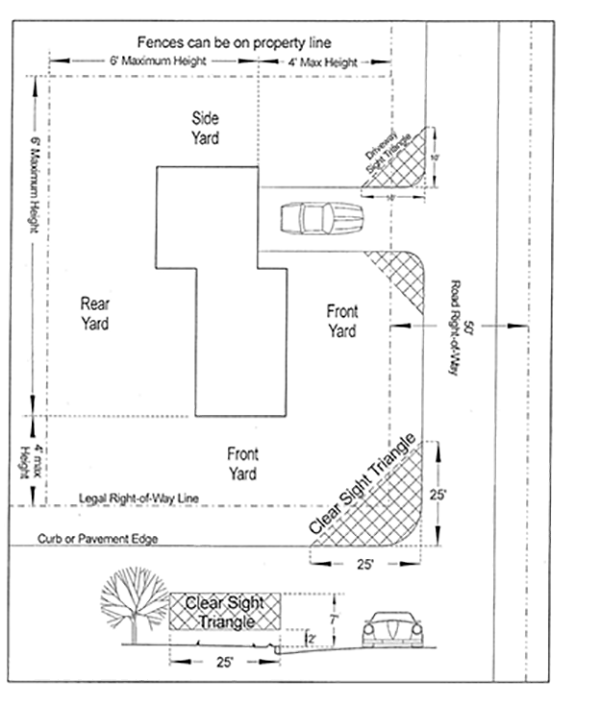Shed Information
Background: The provisions of the Borough of Doylestown Code of Ordinance, PAUCC, and the ICC Property Maintenance Code, shall control the design and installation of sheds and accessory buildings.
Although most buildings are subject to property line setback requirements and other bulk dimensional requirements, certain small, residential sheds are permitted to have some flexibility in placement.
- The minimum rear yard and side yard(s) shall be 2 1/2 feet, provided that the maximum area shall not exceed 100 square feet, the maximum height shall not exceed eight feet; only one such storage shed shall be permitted on any property, and such storage sheds shall not be located closer to any street than the rearmost wall of the principal building.
- No storage shed shall be permitted within the required front yard on any property nor shall any storage shed be located closer to the front yard of any abutting property than as the yard requirements of the applicable zoning district may otherwise require.
- As to attached storage sheds or those with a height greater than eight feet or area larger than 100 square feet, the front, rear and side yard setbacks of principal and accessory buildings within the applicable zoning district shall govern.
Definitions: Storage Shed – A structure enclosed on all sides with roof, not to exceed 8 feet in height or 100 square foot in area in area for the storage of lawn, garden and swimming pool equipment.
Permit Requirements: Installation of any shed requires a permit.
Planning Considerations
- Sheds must be less than 8 feet high and 100 square foot or less. Any structure that exceeds either of these measurements is a building and must comply with zoning restrictions for a building.
- Sheds are not permitted in front yards. Check the required front yards in your zoning district.
- Only one shed is permitted on the property.
Fence Information
Background: The provisions of the Borough of Doylestown Code of Ordinance, PAUCC, and the ICC Property Maintenance Code, and they shall control the design and installation of fences.
Definitions: Fence - a man-made barrier erected for purposes, including, but not limited to, enclosure, exclusion, protection, privacy, screening, security, retainment and aesthetics and located at the perimeter of or within the required yards of private property. This definition shall include the term 'wall" as it is commonly used.
Permit Requirements: Installation of any fence requires a permit. A permit is also required for fence replacement or any repair of existing fences exceeding 50% or more of the value of the existing fence.
Fence Requirements:
- All fences and screens must be erected within the property lines, and no fence or screen shall be erected or planted so as to encroach upon a public right-of-way.
- See-through fences shall not exceed six feet in height when erected in the rear and side yards. When erected in the front yard, such see-through fence shall not exceed four feet in height. Be aware that corner properties have two “front” yards.
- Solid fences or screens shall not exceed six feet in height and shall not be permitted in front yards.
- Fences shall have their most pleasant or decorative side facing the adjacent lot with all support posts and stringers facing inward toward the owner's yard unless such posts or supports are an integral part of the decorative design of the fence.
- Fences shall not create a hazard, impede traffic visibility or be installed within 6 feet of a fire hydrant.
- Fences must be kept in good condition, properly maintained and may not contain any signs, writing or graffiti.
- If posts or supporting members are in or on the ground, they shall be of decay corrosion- and termite-resistant material, whether treated or natural.
Sight Triangle Requirement
No fence or other obstruction is permitted to be within a sight triangle. The sight triangle the area of visibility required on a corner to allow for the safe operation of vehicles, trains, pedestrians, and cyclists in the proximity of intersecting streets, rail lines, sidewalks, and bicycle paths.
A sight triangle is the triangular area found by measuring back 25 feet along the street lines of both streets from the point where they intersect and then connecting the points found with a straight line. (See illustration below) The area within that triangle must be kept clear between 2 foot above curb level and 7 feet above curb level.

Living Fences:
Living fences are subject to all of the provisions of this chapter, except that they shall be exempt from the permit provisions of this chapter. In addition, the living fence shall be planted so that the projected mature size of the living fence shall not be closer than two feet to any sidewalk in existence, any prospective sidewalk or lot line. Living fences must be maintained in a neatly trimmed condition and shall not interfere with the visibility of vehicular and pedestrian traffic.
Exempt Fences:
The following fences are exempt from permit requirements, and at the discretion of the Zoning Officer, from the provisions of this Article, provided that they are not so constructed as to obstruct the vision of motor vehicle operators or to create other hazards to public safety:
- Temporary fences constructed of materials approved by the Zoning Officer and not in excess of six feet in height which are erected at a construction site for the purpose of security and protection.
- Fences erected at the order of the Zoning Officer for the protection of the public.
- Decorative fences not exceeding 18 inches in height and garden fences not exceeding 24 inches in height.
The information provided in this guide is intended only to assist individuals in understanding the code requirements. It is not a complete recitation of the code. Property owners should consult the Doylestown Borough Code of Ordinance for answers to specific questions.








